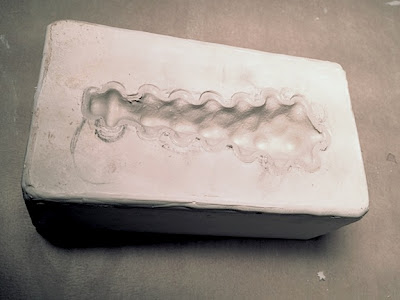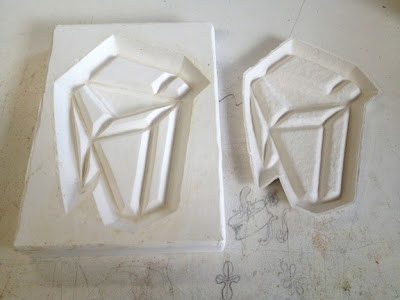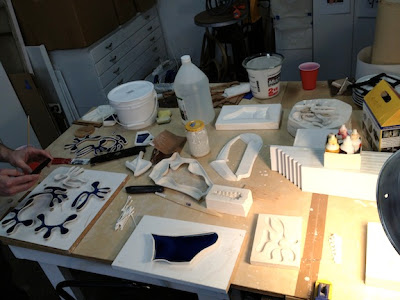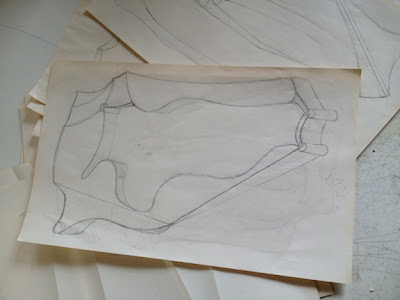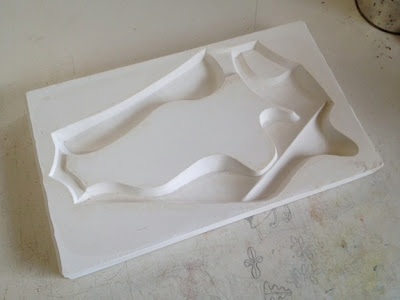Been working on a series of sculptures that walk the line between snow globe and lab specimen.
I've never made a snow globe before, so I turned to the world of DIY videos. It's surprising how many there are out there, and how 90% of them are doing it wrong. For one thing, you have to submerge the globe in water while putting the lid on, other wise there is no way to prevent air bubbles.
I know what you are saying, Well mister smarty pants, I see an air bubble in your snow globe! Yes you do, and that is because I didn't presoak the ceramic sculpture before putting the lid on the globe. That air was trapped inside the pores of the ceramic. Who would have ever thought of that?
You might also be saying, Looks a little green inside that magical wonderland. That's probably due to the algae feeding on the proteins from the egg shells. Egg shells and mother of pearl are what they used before the invention of plastic snow flakes. That said, I kind of like the green. It adds a bit of realism to the old, musty lab specimen effect.
Tuesday, June 11, 2013
Wednesday, May 1, 2013
The Next Big Thing...
Well I don't know if Pinerest is going to really be the NEXT big think, but there is a lot of buzz around it, so I signed up for it. Wouldn't you know that my name is already taken. (One of the reasons to sign up early on these kinds of social networks) So here is the HTML address I ended up with http://pinterest.com/bradfordsmith13.
After you look through my stuff and move onto the sea of pictorial rabbit holes known as Pinterest, you will loose hours of your life looking at all the wonderful pictures that people have pinned.
As for weather Pinterest is a useful site and not just a time suck, I haven't decided yet. I have seen lots of wonderful art that is of a much higher quality than what I have found on Flicker.
The original Pinterest idea was that people would pin images that would link back to the original web site. I have found some new artists websites already. But! A good portion of the images have been detached from their original source, so they now float around the Pinterest sea being pinned over and over without the artist getting any credit or recognition.
After you look through my stuff and move onto the sea of pictorial rabbit holes known as Pinterest, you will loose hours of your life looking at all the wonderful pictures that people have pinned.
As for weather Pinterest is a useful site and not just a time suck, I haven't decided yet. I have seen lots of wonderful art that is of a much higher quality than what I have found on Flicker.
The original Pinterest idea was that people would pin images that would link back to the original web site. I have found some new artists websites already. But! A good portion of the images have been detached from their original source, so they now float around the Pinterest sea being pinned over and over without the artist getting any credit or recognition.
Sunday, April 21, 2013
A Week With Li-Qua-Che 4.0
The nubby club is framed by plastic retaining walls to create a form to pour the plaster into. The model and walls are lightly sprayed with PAM as a release agent.
Here is the plaster mold after hardening. It still has the oil clay club in place which came out easily with the help of a pick to grab the oil clay and lift it out.
The mold is cleaned with a little naphtha to remove any oil residue. Now is also the time to clean the mold of any surface anomalies.
The mold is filled with Li-Qua-Che. After waiting 5 minutes the Li-Qua-Che is poured out leaving behind a 1/8" leather hard layer of Li-Qua-Che in the mold. In the photo you can see the Li-Qua-Che shell is pulling away from the plaster walls as it dries and shrinks.
Here are the two cast sides pulled from the same mold. In theory these two sides should fit together perfectly. But due to the shrinkage ratio of the Li-Qua-Che, the edges shrink back more than the surface areas. This creates edges that are thin, pointy and uneven. Keep that in mind when building your model. All edges need to be extended so that in the edges of the finished casting can be sanded back to create smooth even joins.
So, here is the nubby club glued together and the seams filled with spackle. Note that the surface shows finger prints and boogers found on the original oil clay model. If you don't clean up the model and/or clean the surface of the mold, you'll be cleaning those finger prints and boogers off every casting.
Well, That concludes our week of playing with Li-Qua-Che. I haven't even touched our projects that used two part molds. But I think that's more than enough posting about this topic. Any more and I will need to open an online Li-Qua-Che store, and that would expose me to way to many questions pertaining to doll heads.
Thursday, April 18, 2013
A Week With Li-Qua-Che 3.0
Due to the Dallas Art Fair with 83 galleries, multiple lectures and a few side art events, plus posting about the art fair for Art and Seek, these last two BFS blog posts about Li-Qua-Che had to be postponed until this week. Anyway, back to fun with liquid paper mache... Size does make a difference.
This photo shows the plaster mold and the back side of the cast tile. The compactness of this tile design avoided issues of warpage. The tile also held up to the stress test of being dropped on the floor. (An accident that we will take credit for doing)
We did notice that the edges of the tile were a bit ruff. With that in mind, when designing a one piece mold, the model should be fabricated a little taller so the ragged edges can be sanded down to form a straight, smooth edge.
Tuesday, April 2, 2013
Discovering Free Dallas Art Fair Tickets
The fifth annual Dallas Art Fair is just around the corner, and with 83 galleries in this years line up, 40 of which are first time participants, I am starting to get really excited to see some new and exciting artwork.
While perusing the local media coverage for this event I discovered two wonderful things which I am very excited to share with my BFS Blog subscribers. First is the new art and entertainment website CultureMap. They have been around for a while but I just found out about them.
The second discovery is that CultureMap in their post Enthusiasts Experience Dallas Art Fair for Free on Professionals Day posted a pass code that allows you to purchase free tickets to the Dallas Art Fair!
NOW you have no excuse to miss the most important art event in the DFW metroplex!
While perusing the local media coverage for this event I discovered two wonderful things which I am very excited to share with my BFS Blog subscribers. First is the new art and entertainment website CultureMap. They have been around for a while but I just found out about them.
The second discovery is that CultureMap in their post Enthusiasts Experience Dallas Art Fair for Free on Professionals Day posted a pass code that allows you to purchase free tickets to the Dallas Art Fair!
NOW you have no excuse to miss the most important art event in the DFW metroplex!
Tuesday, March 26, 2013
A Week With Li-Qua-Che 2.0
This post continues with our week long experiments with Li-Qua-Che. The photo above shows design model #2. The cork sub-straight has been gessoed and oil clay has been added to smooth out and build up the surface.
And here is the finished Li-Qua-Che casting. The Li-Qua-Che picks up every detail including scratches and finger prints. So make you model as smooth as possible, and then smooth the walls of the plaster mold as well.
There was some difficulty getting the casting out of the mold, but with the help of a small pallet knife, it finally came free. The real issue was that while the casting was sitting on the table curing, it began to sag and warp.
Summing up our experiments so far, this material is surprisingly strong, but it has size limitations. It will not hold its shape if casting a single sided tile over 10" in size. With that in mind we'll move onto designing two more projects; a smaller 8" tile, and an object that is similar in proportion to a doll head.
Here's a link to some more Li-Qua-Che tips at Konittajo's Playhouse.
This is the plaster mold pulled from the above model. It has cured in the oven over night. The mold measures about 12" square.
There was some difficulty getting the casting out of the mold, but with the help of a small pallet knife, it finally came free. The real issue was that while the casting was sitting on the table curing, it began to sag and warp.
Summing up our experiments so far, this material is surprisingly strong, but it has size limitations. It will not hold its shape if casting a single sided tile over 10" in size. With that in mind we'll move onto designing two more projects; a smaller 8" tile, and an object that is similar in proportion to a doll head.
Here's a link to some more Li-Qua-Che tips at Konittajo's Playhouse.
Friday, March 22, 2013
A Week With Li-Qua-Che 1.0
My good friend and fellow artist Kent Peaslee came down from Chicago to spend a week with me playing with Li-Qua-Che. It was like creating our own artists residency.
What is Li-Qua-Che? Basically it's a liquid paper mache that has been refined to the point that it looks more like porcelain slip. It's designed to make slip castings of things like doll heads.
During our week of investigation, we played with a lot of casting techniques, learning a lot and pushing the product to its limits. Over the next four BFS blog posts I'll be reviewing projects that focus on casting a tile from a one piece mold.
Our first project was to create an 8"x11" sculptural tile that incorporates an open space in the center of the tile. Above is the original design drawing.
Now for some casting. Here the Li-Qua-Che has been poured into the mold. After waiting 8 minutes it was poured out of the mold. What remains is a 1/8" thick wall of Li-Qua-Che (The gray stuff).
The Li-Qua-Che shrinks 4-7% as it dries. Just like slip casting with ceramic slip, it pulls away from the walls releasing itself. In theory, as long as there are not undercuts, the casting, after 30-60 minutes should just drop out of the mold. Unfortunately our design with the big open space in the middle of the tile created a large solid form that the Li-Qua-Che locked onto as it shrank. Getting it out of the mold caused cracks in the casting. After curing, the casting simply fell apart at the weakest structural points.
What is Li-Qua-Che? Basically it's a liquid paper mache that has been refined to the point that it looks more like porcelain slip. It's designed to make slip castings of things like doll heads.
During our week of investigation, we played with a lot of casting techniques, learning a lot and pushing the product to its limits. Over the next four BFS blog posts I'll be reviewing projects that focus on casting a tile from a one piece mold.
Our first project was to create an 8"x11" sculptural tile that incorporates an open space in the center of the tile. Above is the original design drawing.
In this photo we are building the sub-straight for the tile using sheets of cork. We then covered the cork with oil clay and added some details.
This is the plaster mold we pulled from the model. The mold was placed in a warm oven to speed the evaporation of the water from the plaster. Be careful doing this as the plaster will go through thermal shock if it gets too hot too quickly or cools down too fast.
Now for some casting. Here the Li-Qua-Che has been poured into the mold. After waiting 8 minutes it was poured out of the mold. What remains is a 1/8" thick wall of Li-Qua-Che (The gray stuff).
The Li-Qua-Che shrinks 4-7% as it dries. Just like slip casting with ceramic slip, it pulls away from the walls releasing itself. In theory, as long as there are not undercuts, the casting, after 30-60 minutes should just drop out of the mold. Unfortunately our design with the big open space in the middle of the tile created a large solid form that the Li-Qua-Che locked onto as it shrank. Getting it out of the mold caused cracks in the casting. After curing, the casting simply fell apart at the weakest structural points.
Subscribe to:
Comments (Atom)






